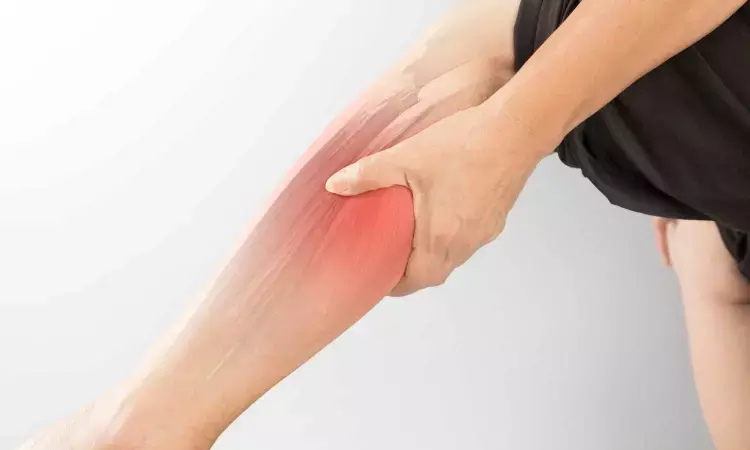- Home
- Medical news & Guidelines
- Anesthesiology
- Cardiology and CTVS
- Critical Care
- Dentistry
- Dermatology
- Diabetes and Endocrinology
- ENT
- Gastroenterology
- Medicine
- Nephrology
- Neurology
- Obstretics-Gynaecology
- Oncology
- Ophthalmology
- Orthopaedics
- Pediatrics-Neonatology
- Psychiatry
- Pulmonology
- Radiology
- Surgery
- Urology
- Laboratory Medicine
- Diet
- Nursing
- Paramedical
- Physiotherapy
- Health news
- Fact Check
- Bone Health Fact Check
- Brain Health Fact Check
- Cancer Related Fact Check
- Child Care Fact Check
- Dental and oral health fact check
- Diabetes and metabolic health fact check
- Diet and Nutrition Fact Check
- Eye and ENT Care Fact Check
- Fitness fact check
- Gut health fact check
- Heart health fact check
- Kidney health fact check
- Medical education fact check
- Men's health fact check
- Respiratory fact check
- Skin and hair care fact check
- Vaccine and Immunization fact check
- Women's health fact check
- AYUSH
- State News
- Andaman and Nicobar Islands
- Andhra Pradesh
- Arunachal Pradesh
- Assam
- Bihar
- Chandigarh
- Chattisgarh
- Dadra and Nagar Haveli
- Daman and Diu
- Delhi
- Goa
- Gujarat
- Haryana
- Himachal Pradesh
- Jammu & Kashmir
- Jharkhand
- Karnataka
- Kerala
- Ladakh
- Lakshadweep
- Madhya Pradesh
- Maharashtra
- Manipur
- Meghalaya
- Mizoram
- Nagaland
- Odisha
- Puducherry
- Punjab
- Rajasthan
- Sikkim
- Tamil Nadu
- Telangana
- Tripura
- Uttar Pradesh
- Uttrakhand
- West Bengal
- Medical Education
- Industry
Lamotrigine useful alternative to Mexiletine for Non-dystrophic Myotonias: Lancet

A recent groundbreaking trial conducted in London United Kingdom revealed that lamotrigine is as effective as mexiletine and can be used as an alternative drug for non-dystrophic myotonias. The trial results were published in the journal The Lancet Neurology.
Non-dystrophic myotonias are a group of rare genetic neuromuscular disorders stemming from ion channel dysfunction. They predominantly occur in the first two decades of life leading to lifelong morbidity. They affect skeletal muscle relaxation and typically affect the legs. There is no cure for this condition except for symptomatic management which includes usage of sodium channel blockers. Research done in the past has shown that Mexiletine which is a sodium channel blocker can be used symptomatically to improve the quality of life. Recent research has also shown the effectiveness of lamotrigine for the symptomatic management of myotonias. Hence, researchers conducted a head-to-head trial to compare mexiletine and lamotrigine and the non-inferiority of lamotrigine.
A randomized, double-blind, crossover, non-inferiority, phase 3 trial was carried out at the National Hospital for Neurology and Neurosurgery (London, UK) by including individuals aged ≥18 years who had genetically confirmed symptomatic non-dystrophic myotonia. The participants were randomly assigned (1:1), employing a block randomization schedule created by a computer program, to receive either mexiletine for 8 weeks followed by lamotrigine for 8 weeks, or lamotrigine followed by mexiletine, with a 7-day washout period in between.
Masking of the investigators and participants was done during treatment allocation. The primary outcome measure was the mean interactive voice response (IVR) diary stiffness score (0–9 scale) over the participant's final 2 weeks of diary reporting in each treatment period. A mixed-effects model was used to assess the non-inferiority with a predefined margin of 0·5 and included all randomly assigned participants who contributed at least 7 days of IVR-diary data in either treatment period.
Findings:
- About 60 participants were screened (24 females and 36 males) and randomly assigned between Aug 1, 2021, and Dec 12, 2022, to either the mexiletine–lamotrigine sequence (n=30) or the lamotrigine–mexiletine sequence (n=30).
- Among them, 53 participants contributed data to the primary analysis.
- Post-treatment with the drugs, the mean IVR stiffness score with mexiletine was 2·54 versus 2·77 with lamotrigine (mean mexiletine–lamotrigine difference −0·23).
- Indigestion–reflux was the most common adverse event reported (eight participants, 208 participant-days receiving mexiletine; seven participants, 130 participant-days receiving lamotrigine).
- No serious adverse events were reported.
Thus, the trial concluded that lamotrigine was as effective as mexiletine. Despite the lack of definitive evidence for non-inferiority both the medications displayed similar efficacy. This suggests that lamotrigine can be used as an alternative to mexiletine. This trial offers critical insights for clinicians to offer therapeutic options to patients based on patient's acceptance.
Further reading: Vivekanandam V, Skorupinska I, Jayaseelan DL, et al. Mexiletine versus lamotrigine in non-dystrophic myotonias: a randomised, double-blind, head-to-head, crossover, non-inferiority, phase 3 trial. Lancet Neurol. 2024;23(10):1004-1012. doi:10.1016/S1474-4422(24)00320-X
BDS, MDS
Dr.Niharika Harsha B (BDS,MDS) completed her BDS from Govt Dental College, Hyderabad and MDS from Dr.NTR University of health sciences(Now Kaloji Rao University). She has 4 years of private dental practice and worked for 2 years as Consultant Oral Radiologist at a Dental Imaging Centre in Hyderabad. She worked as Research Assistant and scientific writer in the development of Oral Anti cancer screening device with her seniors. She has a deep intriguing wish in writing highly engaging, captivating and informative medical content for a wider audience. She can be contacted at editorial@medicaldialogues.in.
Dr Kamal Kant Kohli-MBBS, DTCD- a chest specialist with more than 30 years of practice and a flair for writing clinical articles, Dr Kamal Kant Kohli joined Medical Dialogues as a Chief Editor of Medical News. Besides writing articles, as an editor, he proofreads and verifies all the medical content published on Medical Dialogues including those coming from journals, studies,medical conferences,guidelines etc. Email: drkohli@medicaldialogues.in. Contact no. 011-43720751




